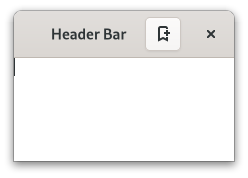HeaderBar
Superclasses: Widget, InitiallyUnowned, Object
Implemented Interfaces: Accessible, Buildable, ConstraintTarget
GtkHeaderBar is a widget for creating custom title bars for windows.

GtkHeaderBar is similar to a horizontal GtkCenterBox. It allows
children to be placed at the start or the end. In addition, it allows
the window title to be displayed. The title will be centered with respect
to the width of the box, even if the children at either side take up
different amounts of space.
GtkHeaderBar can add typical window frame controls, such as minimize,
maximize and close buttons, or the window icon.
For these reasons, GtkHeaderBar is the natural choice for use as the
custom titlebar widget of a GtkWindow (see set_titlebar),
as it gives features typical of titlebars while allowing the addition of
child widgets.
GtkHeaderBar as GtkBuildable
The GtkHeaderBar implementation of the GtkBuildable interface supports
adding children at the start or end sides by specifying “start” or “end” as
the “type” attribute of a <child> element, or setting the title widget by
specifying “title” value.
By default the GtkHeaderBar uses a GtkLabel displaying the title of the
window it is contained in as the title widget, equivalent to the following
UI definition:
<object class="GtkHeaderBar">
<property name="title-widget">
<object class="GtkLabel">
<property name="label" translatable="yes">Label</property>
<property name="single-line-mode">True</property>
<property name="ellipsize">end</property>
<property name="width-chars">5</property>
<style>
<class name="title"/>
</style>
</object>
</property>
</object>
CSS nodes
headerbar
╰── windowhandle
╰── box
├── box.start
│ ├── windowcontrols.start
│ ╰── [other children]
├── [Title Widget]
╰── box.end
├── [other children]
╰── windowcontrols.end
A GtkHeaderBar’s CSS node is called headerbar. It contains a windowhandle
subnode, which contains a box subnode, which contains two box subnodes at
the start and end of the header bar, as well as a center node that represents
the title.
Each of the boxes contains a windowcontrols subnode, see
WindowControls for details, as well as other children.
Accessibility
GtkHeaderBar uses the GROUP role.
Constructors
Methods
- class HeaderBar
-
- get_show_title_buttons() bool
Returns whether this header bar shows the standard window title buttons.
- get_title_widget() Widget | None
Retrieves the title widget of the header.
See
set_title_widget.
- pack_end(child: Widget) None
Adds
childtobar, packed with reference to the end of thebar.- Parameters:
child – the
GtkWidgetto be added tobar
- pack_start(child: Widget) None
Adds
childtobar, packed with reference to the start of thebar.- Parameters:
child – the
GtkWidgetto be added tobar
- remove(child: Widget) None
Removes a child from the
GtkHeaderBar.The child must have been added with
pack_start,pack_endorset_title_widget.- Parameters:
child – the child to remove
- set_decoration_layout(layout: str | None = None) None
Sets the decoration layout for this header bar.
This property overrides the
gtk_decoration_layoutsetting.There can be valid reasons for overriding the setting, such as a header bar design that does not allow for buttons to take room on the right, or only offers room for a single close button. Split header bars are another example for overriding the setting.
The format of the string is button names, separated by commas. A colon separates the buttons that should appear on the left from those on the right. Recognized button names are minimize, maximize, close and icon (the window icon).
For example, “icon:minimize,maximize,close” specifies an icon on the left, and minimize, maximize and close buttons on the right.
- Parameters:
layout – a decoration layout, or
Noneto unset the layout
- set_show_title_buttons(setting: bool) None
Sets whether this header bar shows the standard window title buttons.
- Parameters:
setting –
Trueto show standard title buttons
- set_title_widget(title_widget: Widget | None = None) None
Sets the title for the
GtkHeaderBar.When set to
None, the headerbar will display the title of the window it is contained in.The title should help a user identify the current view. To achieve the same style as the builtin title, use the “title” style class.
You should set the title widget to
None, for the window title label to be visible again.- Parameters:
title_widget – a widget to use for a title
Properties
- class HeaderBar
- props.decoration_layout: str
The decoration layout for buttons.
If this property is not set, the
gtk_decoration_layoutsetting is used.
- props.show_title_buttons: bool
Whether to show title buttons like close, minimize, maximize.
Which buttons are actually shown and where is determined by the
decoration_layoutproperty, and by the state of the window (e.g. a close button will not be shown if the window can’t be closed).